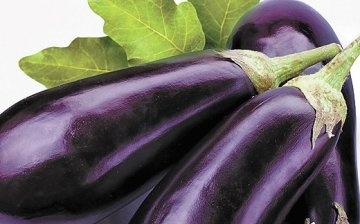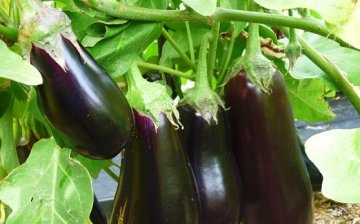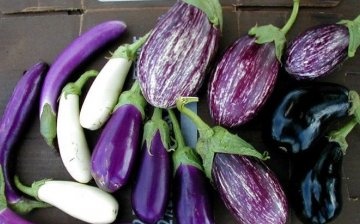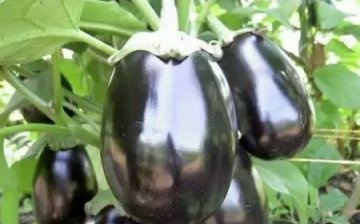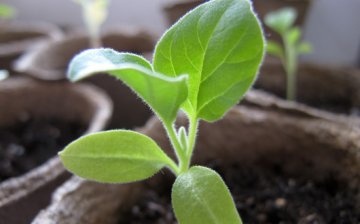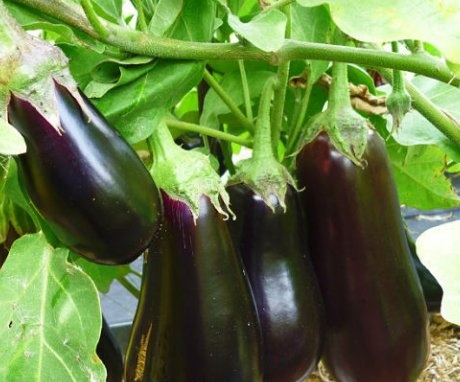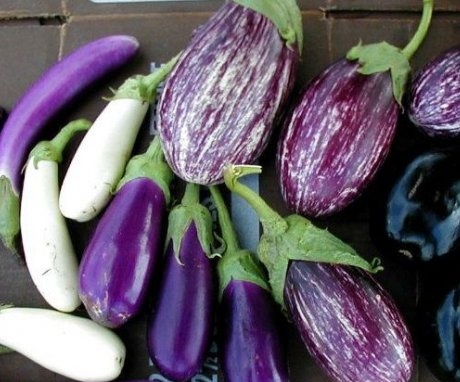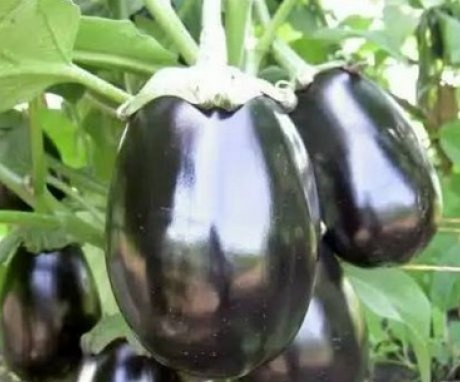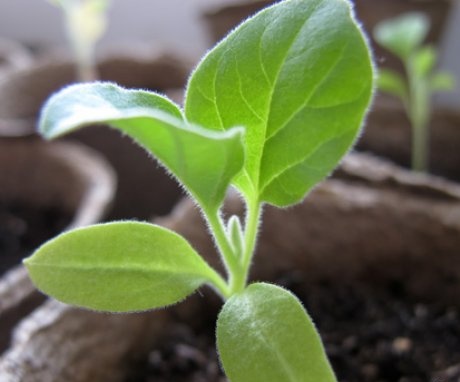Eggplants: varieties, sowing for seedlings and care
Eggplant belongs to the nightshade family. Their homeland is India, and in Europe it appeared only in the 19th century. Many considered the fruits of this plant poisonous and for this reason it was not used for food for a long time.
Characteristics of eggplant
- Characteristics of eggplant
- Eggplant varieties
- Eggplant care
- Sowing eggplants for seedlings
- Diseases and pests
Characteristics of eggplant
Nowadays, eggplant is widely used in cooking. They are cooked in the oven, pickled and canned. In many countries, this product is used as often as, for example, tomato, which also belong to the nightshade family.
Description of eggplant:
- Eggplant is an annual plant.
- His rhizome is fibrous, grows strongly on soft loose soils. Its length can reach 1.5 meters.
- On heavy clay soils, the root grows by only 50 cm.
- Eggplant stems are strong, branching, strongly pubescent. Have
- of an adult plant, the base stiffens.
- The color of the stems depends on the type of plant. For many, they are green, and purple at the tips of the branches. There are also completely purple bushes.
- The height of the bush can reach 1.5 meters.
- Eggplant leaves are large, differ in shape and size depending on the variety. There are oval, ovoid and elongated, solid and slotted.
- Medium-sized flowers are usually purple, light purple or pink.
- The fruit is a large berry that can be dark purple, brown, white, red or green in color.
- Fruit size and shape depends on the variety. They are round, cylindrical, oblong and oval.
Eggplant varieties
Description of the most popular varieties of eggplant:
- Nadir. This is an early plant variety. Fruits ripen 2 months after transplanting. Bushes are small up to 05 meters in height, medium branching. The fruits are found mainly on the lower part of the plant. Their shape is cylindrical, the skin is shiny, glossy and smooth. In size, the fruits can grow in length by 18 cm in width by 6 cm. Their flesh is light, tender, without bitterness.
- Negus. An early variety of eggplant. Ripens 70 days after the seedlings are planted. The height of the bush is average and reaches 50 cm. The branches are strong, branching. Fruits are bright purple in color, oval in shape, with a hard glossy skin. The pulp is light and without bitterness.
- Paris. Also applies to early varieties, ripens 70 days after planting. Bushes are high, up to 80 cm, branching with a thick stem. The fruits are oblong cylindrical in shape, grows in length by 30 cm in width - by 6 cm. The skin is dark purple, shiny. The pulp is light, without bitterness.
- Swan. The variety is mid-season. The fruits ripen 3.5 months after germination. The bush is high, up to 70 cm, medium branching. The leaves are large, oblong, colored in a light green tone. Small flowers are painted white. The fruits of this variety are also white in color. They have a cylindrical shape, in length it grows by 22 cm, in width by 7 cm. The flesh is tender, light, does not have a bitter aftertaste.
- Japanese red. This early variety is resistant to cold temperatures. Therefore, for planting in open ground, an average heated temperature is also suitable.Fruit ripening occurs 3 months after germination. The bush is tall, branching, spreading. Plant height can reach 80 cm. The foliage is large, colored in a light green tone. Fruits are round, slightly flattened. Their skin is unusual red or orange, glossy and smooth. The pulp is yellow, without bitterness, tender.
- Black handsome. Refers to mid-season varieties according to the ripening period. Fruits can be harvested 4.5 months after germination. The bush is medium, fast-growing, up to 60 cm high. The leaves are large, oval-oblong, painted in a green tone. The fruits are pear-shaped. Their skin is black-purple, shiny, glossy. The pulp has a greenish tint, dense.
Eggplant care
For planting, you need to choose a place where root crops grew in the previous year, cabbage or bow. It is also recommended not to plant eggplants in the old place for 3 years. The selected area should be bright and well warmed up by the sun. The optimum temperature for most varieties is 20-25 degrees, when the temperature drops or rises by 3-4 degrees, the ovary may fall off.
Watering the eggplant:
- Eggplants are moisture-loving plants, therefore watering should be regular and abundant, especially during the hot season.
- In rainy weather, it is cut.
- After each watering, it is recommended to loosen the soil near the bushes - this enriches it with oxygen.
Weeds also need to be removed. This is especially true within 3-5 weeks after transplanting. It is recommended to feed eggplant bushes with nitrogen fertilizers. When the buds appear, you can add a little mineral dressing.
In order for large and strong fruits to ripen on the bush, it is recommended to pinch the top and leave several strong branches.
With abundant flowering, the fruits will form small. Therefore, you can remove a small number of flowers.
Sowing eggplants for seedlings
Eggplants are propagated by the seeds in their fruits. There are many different varieties of this plant on the market. You can buy several of them and plant them on seedlings. Most varieties produce large and tasty eggplants.
Seedlings are sown in the early spring months. Before planting in the greenhouse, 2 months should pass after the seeds germinate. Large plants are already planted in the ground, so if there is no greenhouse, you need to wait 3 months. With this calculation, seeds are sown for seedlings.
Before sowing, the seeds must be disinfected.
To do this, they are poured with a solution of potassium permanganate for 30 minutes, after which they are kept in wet gauze for 24 hours. Further, the seeds can be planted in a prepared container. After sowing, future seedlings are transferred to a bright place. For strong sprouts to germinate, light must hit the plants for 13-14 hours. The days are short in March and April, so special artificial lighting must be turned on.
It is also necessary to maintain the correct temperature regime. When the seeds hatch and small sprouts appear, the environment should warm up to 17 degrees. This regime is maintained for 1-2 weeks. Further, in the daytime, the room where the seedlings are located warms up to 20-25 degrees, at night the temperature should be within 17 degrees.
It is very important to water the seedlings correctly and regularly:
- After planting, this process is carried out using a spray bottle.
- The soil should be moist, but not marshy.
- After the sprouts appear, it is necessary to water them at the root, without touching the foliage.
- Water is best used soft and warm.
- Along with watering, fluoride fertilizers can be applied to strengthen the plant. Top dressing is done once every 2 weeks..
Two weeks before planting seedlings in the soil, it must be dived. To do this, each individual sprout is transferred into its own container of no more than 0.6 liters of volume.A mixture of soil soil is poured into such pots, where eggplant and seedling mixtures purchased in a special store will grow. When transferring a plant to a pot, you can shorten the root a little, this will make it possible for the bush to strengthen.
Diseases and pests
Of the pests, the Colorado potato beetle threatens the eggplant most of all. For him, eggplant tastes better than potato... To avoid such a problem, it is necessary to choose a planting site away from the potatoes. You can also treat the bushes with infusion or decoction of wormwood or celandine. Chemical preparations are recommended to be applied 3 weeks before the formation of ovaries.
Otherwise, harmful substances will get on the fruits and they will become unsuitable for human consumption.
Also, the plant is susceptible to attack by spider mites and aphids. This rarely happens, but it is worth checking the plant regularly in order to take timely measures to cure it.
Diseases in a plant are with improper care. With a strong overflow or insufficient watering, the bush drops flowers. The same happens at elevated temperatures or in cold weather.
More information can be found in the video.



